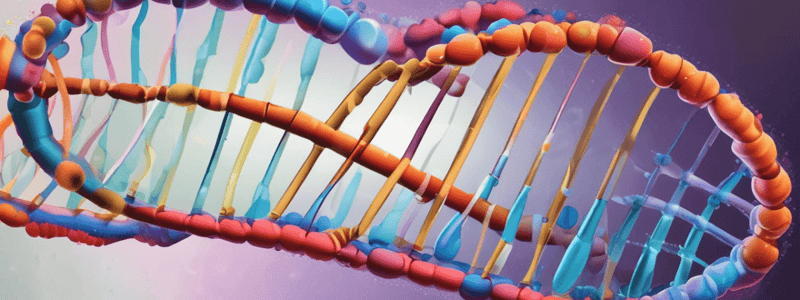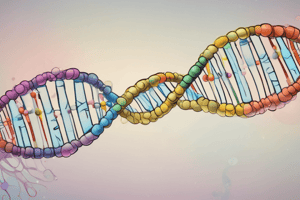Podcast
Questions and Answers
What is the primary mechanism that ensures the high fidelity of DNA replication?
What is the primary mechanism that ensures the high fidelity of DNA replication?
- The initial base-pairing
- The proofreading step by DNA polymerase (correct)
- DNA topoisomerases
- Several mismatch repair mechanisms
What is the role of DNA polymerase in proofreading during DNA replication?
What is the role of DNA polymerase in proofreading during DNA replication?
- It corrects any initial mispairings that might have occurred
- It removes replication errors that remain in the wake of the replication machine
- It performs the first proofreading step just before a new nucleotide is covalently added (correct)
- It performs the final proofreading step after the nucleotide is covalently added
What is the name of the system that removes replication errors that remain in the wake of the replication machine?
What is the name of the system that removes replication errors that remain in the wake of the replication machine?
- Strand-directed mismatch repair system (correct)
- Proofreading mechanism
- Mismatch repair system
- DNA repair system
What is the characteristic of the DNA replication fork?
What is the characteristic of the DNA replication fork?
What is the purpose of the conformational change in DNA polymerase during proofreading?
What is the purpose of the conformational change in DNA polymerase during proofreading?
What is a characteristic of DNA polymerase that enables it to correct its own errors during DNA synthesis?
What is a characteristic of DNA polymerase that enables it to correct its own errors during DNA synthesis?
What is the direction of DNA synthesis during replication?
What is the direction of DNA synthesis during replication?
What is the purpose of the 3'-to-5' proofreading exonuclease activity of DNA polymerase?
What is the purpose of the 3'-to-5' proofreading exonuclease activity of DNA polymerase?
Why is it necessary for DNA polymerase to have an existing primer to initiate DNA synthesis?
Why is it necessary for DNA polymerase to have an existing primer to initiate DNA synthesis?
What is the result of the stability of the DNA double helix under physiological conditions?
What is the result of the stability of the DNA double helix under physiological conditions?
What is the primary function of DNA helicases in DNA replication?
What is the primary function of DNA helicases in DNA replication?
What is the role of single-strand DNA-binding proteins in DNA replication?
What is the role of single-strand DNA-binding proteins in DNA replication?
In which direction can a DNA helicase move along a single DNA strand to unwind the DNA double helix?
In which direction can a DNA helicase move along a single DNA strand to unwind the DNA double helix?
Why do DNA polymerase molecules synthesize only short strings of nucleotides before falling off the DNA template?
Why do DNA polymerase molecules synthesize only short strings of nucleotides before falling off the DNA template?
What is the consequence of not removing hairpin helices from single-stranded DNA during replication?
What is the consequence of not removing hairpin helices from single-stranded DNA during replication?
What is the approximate mutation rate during DNA replication?
What is the approximate mutation rate during DNA replication?
Why is it essential to maintain low mutation rates in germ cells?
Why is it essential to maintain low mutation rates in germ cells?
What is the significance of maintaining accurate DNA sequences in somatic cells?
What is the significance of maintaining accurate DNA sequences in somatic cells?
What is the estimated number of nucleotide pairs in the human genome?
What is the estimated number of nucleotide pairs in the human genome?
What is the result of the remarkable accuracy of DNA replication in human cells?
What is the result of the remarkable accuracy of DNA replication in human cells?
Flashcards are hidden until you start studying
Study Notes
DNA Replication Mechanisms
- DNA replication involves a sliding ring that holds DNA polymerase onto the DNA strand, creating a collaborative replication machine.
- Eukaryotic and bacterial DNA replication mechanisms share fundamental similarities despite distinct cellular structures.
Mismatch Repair and Fidelity
- Strand-directed mismatch repair systems eliminate replication errors that remain post-replication.
- Ribonucleotide incorporation during replication is accidental but can be corrected by specific repair mechanisms.
Role of DNA Topoisomerases
- DNA topoisomerases prevent tangling of DNA, maintaining appropriate supercoiling during replication.
Proofreading Mechanisms
- High fidelity of DNA replication is critical, relying on initial base-pairing and several proofreading mechanisms to correct errors.
- DNA polymerase performs an initial proofreading step before adding new nucleotides, enhancing accuracy through conformational changes that favor correct base pairing.
Error Correction
- Exonucleolytic proofreading occurs immediately after incorrect nucleotide incorporation, removing mispaired nucleotides using a separate catalytic site on the polymerase.
- DNA polymerase is a self-correcting enzyme that removes its own errors while synthesizing the DNA strand.
Directionality of DNA Replication
- DNA synthesis occurs in a 5'-to-3' direction, facilitating efficient error correction.
- RNA primer synthesis is initiated by specialized nucleotide-polymerizing enzymes.
Role of Helicases and SSB Proteins
- DNA helicases open the DNA double helix at the replication fork, hydrolyzing ATP to power their movement along the DNA.
- Single-strand DNA-binding (SSB) proteins stabilize and protect single-stranded DNA from forming hairpin structures, which can inhibit polymerase activity.
Sliding Ring Nature of DNA Polymerase
- DNA polymerase synthesizes only short segments before detaching from the DNA template; a sliding ring structure helps retain it on the DNA during replication.
Mutation Rates and Maintenance of DNA Sequences
- DNA sequences are maintained with high fidelity, with mutation rates around one nucleotide change per 10 billion replicated nucleotides.
- Accurate replication is essential for transmitting genetic information, ensuring minimal changes in the human genome across cell divisions.
Importance of Mutation Rate Control
- Low mutation rates are vital for survival, protecting germ cells from mutations to maintain species integrity and somatic cells from changes that could lead to cancer.
Studying That Suits You
Use AI to generate personalized quizzes and flashcards to suit your learning preferences.




